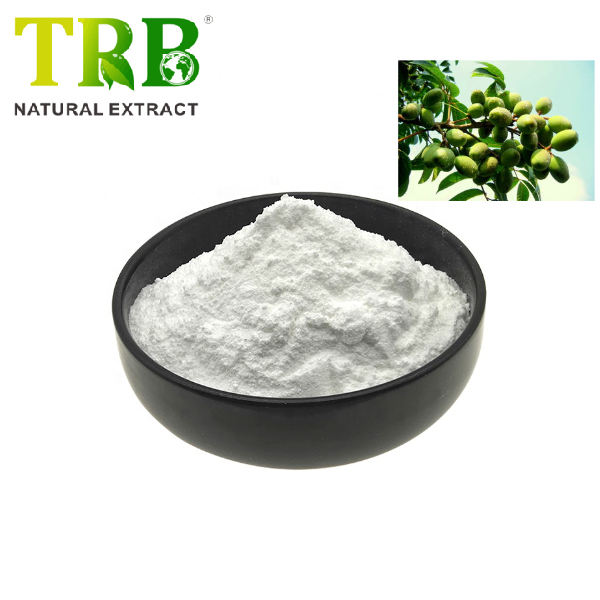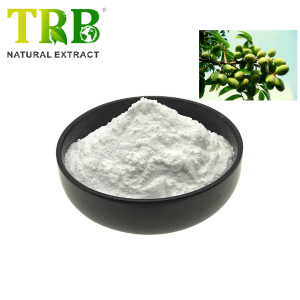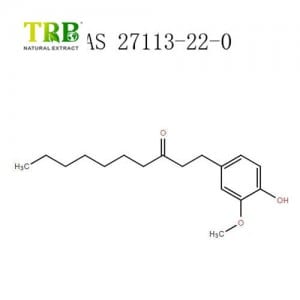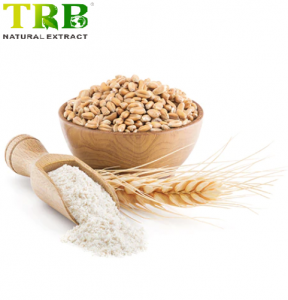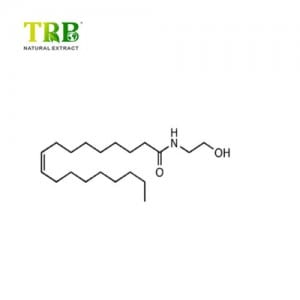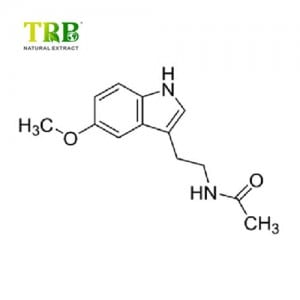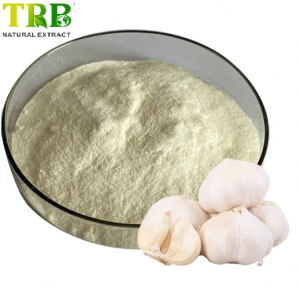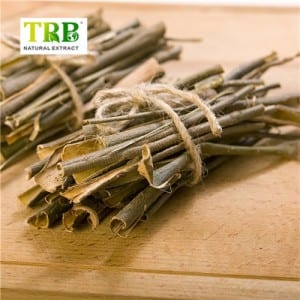Ko te waikawa Oleanolic he triterpenoids pentacyclic e toru kua wehea mai i nga tipu Gentianaceae o Swertia mileensis te katoa o te tarutaru me nga hua privet, he tinana korekore me nga glycosides i roto i nga tipu maha.Ko te waikawa Oleanolic he whanuitanga i roto i nga tipu, a ko te ihirangi toharite ko te 0.2% - 2%.Ko te ihirangi tiketike o Cucurbitaceae ko 1.5% ~ hunchback raro 2%, ihirangi hua privet o 0.6% ~ 0.7%. Ko te waikawa Oleanolic he ahua o te puhui triterpenoid pentacyclic kua wehea mai i nga hua o te puninga Asteraceae, Syzygium sylvestris, Ligustrum lucidum ranei.He kaiawhina mo te mate ate me te whakamahi haumanu mo te mate rongoa.Ko te mate ate ate ate he tino kaha ki te whakaheke i te alanine aminotransferase me te kowhai. Ko te waikawa Oolic he triterpenoids pentacyclic kua wehea mai i te hua o te swertia chinensis me te fructus ligustris mai i te tipu gentianaceae.Ko te waikawa Oleanolic e kitea nuitia ana i roto i nga tipu, me te ihirangi whanui o 0.2% ~ 2% [1].Ko te ihirangi o raro o te tahā ko te 1.5% ~ 2%, ko te ihirangi o te hua o te fructus ligustris he 0.6% ~ 0.7%.Ko te waikawa Oleanolic he karaihe acicular ma (te waiwaro), he kakara, he kore reka.Karekau ki te waikawa me te kawakore.Ira whakarewa o 308 ~ 310 ℃, [alpha] 20 d + 73.3 ° (c = 0.15, chloroform, insoluble in water, soluble in methanol, ethanol, ethyl ether, acetone and chloroform.Ko te waikawa Oleanolic he triterpenoid puta noa, he whanui i roto i nga tipu kai me nga rongoa, e pa ana ki te waikawa betulinic Ka kitea i roto i te Phytolacca americana (American pokeweed), me te Syzygium spp, te karika, me etahi atu.
I kitea te waikawa Oleanolic e whakaatu ana i nga mahi anti-HIV kaha, i whakamahia te waikawa betulinic pūhui e pa ana ki te hanga i te tarukino aukati matuatanga arumoni tuatahi.I rangahau tuatahitia, i wehea mai i nga tipu maha, tae atu ki te Rosa woodsii (rau), Prosopis glandulosa (rau me nga manga), Phordendron juniperinum (te tipu katoa), Syzygium claviflorum (rau), Hyptis capitata (te tipu katoa), me te Ternstromia gymnanthera (whakarererangi rererangi). wahanga).Ko etahi atu momo Syzygium tae atu ki te aporo java (Syzygium samarangense) me nga aporo rohi kei roto.
Ingoa Hua: Oleanolic Acid98%
Whakatakotoranga: 98% na HPLC
Puna Botanic: Olea Europea Extract
Ingoa matū:(3β)-3-Hydroxyolean-12-en-28-oic acid
No CAS:508-02-1
Wāhanga i whakamahia: Rau
Tae: Te paura ma me te kakara me te reka
Tūnga GMO: GMO Free
Tapeke: i roto i te 25kgs pahū muka
Rokiroki: Puritia te ipu kia kore e tuwhera ki te waahi makariri, maroke, mawehe atu i te marama kaha
Te Ora: 24 marama mai i te ra o te whakaputanga
He aha tewaikawa oleanolic?
Ko te waikawa Oleanolic (OA), he waikawa hydroxyl pentacyclic triterpenoid (HPTA) he rite ki te waikawa betulinic, waikawa ursolic;he painga ano he mahi antibacterial, anti-inflammatory, antitumor.

Kei hea koe e kitea aiwaikawa oleanolic?
Ko te waikawa Oleanolic e whakamahia ana mo te maimoatanga o nga momo mate, ka kitea e koe i roto i nga kai me nga tipu whanui.
Ko etahi o nga hua penei i te aporo, te pamekaranete, te rēmana, te bilberries, te oriwa kei roto ano hoki te waikawa oleanolic.

| Ingoa Herb | Te ihirangi waikawa Oleanolic | Tikanga whakamatautau |
| Ligustrum lucidum Ait | 0.8028% | HPLC |
| Verbena Officinalis L | 0.071%-0.086% | HPLC |
| Prunella vulgaris L | 3.47%-4.46% | HPLC |
| Hemsley Chinensis Cogn. | 1.5%~2% | HPLC |
I tenei wa, he otaota HainamanaHemsley Chinensis CognKoia tonu te rawa hokohoko rawa mo te tango waikawa oleanolic.
Hemsley Chinensis Cogn.Kupu Whakataki
Hemsleya chinensis Cogn.he otaota piki ake, he rongoa Hainamana hoki.
Whanau: Cucurbitaceae
Tribus: Gomphogyneae
Te momo: Hemsleya
Nga momo: H. amabilis
Ka tohatohahia te otaota ki nga kawanatanga o Guangxi, Sichuan, Guizhou, Yunnan, Hubei, me etahi atu. I whanau i te taha o te ngahere me nga rakau iti o te raorao i te teitei o te 2,000 mita.
Nga kai kaha: kei roto he Hemslolide Mal, Ma3, H1;Chikusetusaponin-Iva;dihydro cucurbitacin F-25-acetate;dilydrocucurbitacin F;waikawa oleanolic-beta-Hlucosyloleanolate;Hemsamabilinin A;Cu-curbitacinⅡb-2-beta-D-glucopyranoside.
Uara rongoa:
Hemsleya chinensis Cogn.Ko te nuinga mo te whakakore, te whakahoromata, te anti-inflammatory, te whakapakari i te puku me te whakaora i te mamae.I tenei wa, kei reira nga tangohanga paura, he rongoa rongoa penei i nga kapene, papa, pire gastrointestinal, aha atu, e whakamahia nuitia ana i roto i nga mahi haumanu.

Te tangohanga o te waikawa Oleanolic maiHemsleya Chinensis Cogn.

Ko nga tauira kei roto te waikawa Oleanolic i roto i nga taapiri kai
I kitea e matou ko te waikawa oleanolic e whakamahia ana i roto i nga taapiri hauora i ahu mai i nga momo tangohanga tipu e toru: te tangohanga rau Loquat, te tangohanga Hemsley Chinensis, me te tangohanga basil tapu.
- Te paura Basil Tapu (rau) (0.4% te waikawa Ursolic me te waikawa Oleanolic, 2.0 mg)
- Holy Basil supercritical CO2 tangohanga (rau) (Ocimum tenuiflorum Linn.) (2.5% Ursolic acid me Oleanolic acid, 1.5 mg)
- Ko te Tangohanga Loquat (hua) (te whakarato i te waikawa Ursolic, te Waikawa Oleanolic) (Whakatauhia ki te waikawa Ursolic mo ia 125mg)

Oleanolic acid VS Ursolic acid
Ko te waikawa Oleanolic (OA) me te waikawa ursolic (UA) he triterpenoid taiao he rite te hanganga matū.
E mohiotia ana enei puhui triterpenoids kei roto i nga otaota rongoa me nga kai.
He maha o raatau taonga rongoa: hepatoprotective, anti-inflammatory, antimicrobial, hypoglycemic, antimutagenic, mahi anti-HIV, antioxidant, me nga mahi antifertility.

OA me UA rerekētanga:
| Ingoa Hua | waikawa Oleanolic | Te waikawa Ursolic |
| CAS NO. | 508-02-1 | 77-52-1 |
| Pentacyclic triterpenes | β-Amyrin | α-Amyrin |
| Puna otaota | Rau Loquat, Basil Tapu, Rosemary, rau Oriwa.etc. | |
| Whakatakotoranga | 40%,98% paura | 15%,25%,50%,98% paura |
| Te ahua (te tae me te kakara) | 40% he kowhai marama98% he paura ma kahore he kakara | 15%-50% parauri-kowhai, kowhai ranei98%paura maTe ahua |
| Te wehewehe | IR:(1355~1392cm-1) e rua nga tihi(1245~1330cm-1) e toru nga tihiNMR:δ(C12)122.1,δ(C13)143.4 | (1355~1392cm-1) e toru nga tihi(1245~1330cm-1) e toru nga tihiδ(C12)125.5,δ(C13)138.0 |
| Putanga | Oleanolic konutai tote Oleanolic acid phosphate disodium salt3-oxo oleanolic acid bardoxolone methyl (CDDO-Me) | Te tote konutai ursolic me tona waikawa dicarboxylic haurua ester pärönaki pärönaki ursolic acid ketene 3-carbon ursolic acid 3-acetoxyursolic waikawa |
| Ka taea te mate pukupuku | He rongonui ake a UA i a OA. | |
Nga Mahi Koiora o te Waikawa Oleanolic
-
Nga Painga Anti-Tumour/Anti-Cancer
Te aukati o te waikawa oleanolic i runga i te mate pukupuku hepatocellular na roto i te ERK-p53-whakawaenga i te hopu huringa pūtau me te apoptosis e whakawhirinaki ana ki te mitochondrial.
– na Xin Wang, Hua Bai, me etahi atu Kairangahau
I whakaatu te OA i te awenga aukati ki te HCC na roto i te whakaurunga o te apoptosis me te hopu huringa pūtau i roto i nga pukupuku kua whakatokia me nga pūtau HepG2.
Ko te OA i whakaawehia te apoptosis i roto i te ara mitochondrial, e whakaatuhia ana e te aukati o te Akt / te whainga kararehe o te ara rapamycin.
Na te OA i mauheretia te huringa pūtau G2/M na roto i te ture-whakararo-a-p21 o te hurihanga B1/cdc2.
I whakaatu a OA i nga mahi antitumor nui i roto i te HCC i roto i nga tauira vivo me in vitro.Ko enei raraunga he maarama hou mo nga tikanga e pa ana ki te paanga antitumor o OA.
I tua atu, ko nga rangahau e whakaatu ana ko te OA me tana hua o te Oleanolic acid methyl ester he paanga ano ki te mate pukupuku o te uma, te mate pukupuku o te huhu, te pukupuku pukupuku, te mate pukupuku pukupuku, nga pukupuku pukupuku pancreatic ...

-
Nga Mahi Antimicrobial
Ko te tikanga ka mau a OA i nga mahi antimicrobial ki te maha o nga momo tukumate na te mea he whai waahi nui ki te tiaki i nga tukumate i roto i nga tipu.
I whakaatu te OA i te mahi ngawari ki te Staphylococcus aureus me Bacillus Thuringiensis i te 62.5 µg/mL me te Escherichia coli, Salmonella Enterica, me te Shigella dysenteriae i te 31.2 µg/mL te iti o te kukū aukati (MIC).
-
Hepatoprotective kaha
Ko tetahi o nga mahi koiora o te OA ko te whakamarumaru i te ate mai i te paitini, a kei te whakamahia i tenei wa hei rongoa mo te ate ate i Haina.
I roto i nga kiore Wistar albino, i whakamahia te OA mai i Flaveria Trinervia, a, he nui te awenga whakamarumaru ki te paitini ate ethanol-induced ma te whakahoki mai i nga taumata o te enzyme hepatotoxic serum marker.I tohuhia e tenei rangahau ko te kaha antioxidant o OA tetahi atu tikanga mo tona kaha hepatoprotective.
Waikawa Oleanolic me ona hua

Nga Whakamatautau Haumanu Waikawa Oleanolic
Ko te waikawa Oleanolic (i ahu mai i te oriwa), tata ki te 500 nga whakamatautau haumanu kua rehitatia, i whakaatu i whai hua i roto i nga whakamatautau haumanu mo te mate whatukuhu mau tonu, te mate huka mellitus momo 2, me etahi ahuatanga mumura penei i te mate pukupuku.
Ko te nuinga o nga mea rongonui i roto i nga whakamatautau haumanu ko te bardoxolone methyl (CDDO-Me).I arotakea te CDDO-Me i roto i nga koiora puku, a tera pea ka whai waahi ki te rongoa i nga mate whatukuhu mau tonu, kei te aromatawaihia inaianei mo nga paanga ki te whakaheke toto.
Hainamana Pharmacopoeia Paerewa o Oleanolic Acid
| ingoa hua | Waikawa Oleanolic |
| Tautuhinga | (1)Tangohia te 30mg o tenei hua, hoatu ki roto i te ipuipu whakamatautau, taapirihia te 3ml o te chloroform kia memeha, tāpirihia kia rua nga pata o te waikawa pungatara, wiri mo te 5 meneti, he papura-whero te paparanga chloroform. |
| (2)Tangohia te 20mg o tenei hua, taapirihia te 1ml o te anhydride acetic, ka whakakorehia me te wera iti, ka taapirihia te waikawa pungatara ki te tae papura, ka whakapouri i muri i te whakatakoto. | |
| (3)Tangohia te 10mg o tenei hua, taapirihia te wairewa waikawa acetic vanillin (tangohia te vanillin 0.5g, taapirihia te 10ml o te waikawa acettic glacial kia memeha, ara) 0.2ml, taapirihia te 0.8ml o te waikawa perchloric, ka whakamahana mo etahi meneti i roto i te pati wai.Fuchsia, tāpirihia te 2ml o te ethyl acetate, te papura-whero kua rewa ki te ethyl acetate, ka waiho kia kore e paheke. | |
| (4)Ko te awhi infrared absorption o tenei hua kia rite ki te awhi mana. | |
| Te whakatau i te whakamatautau | Tangohia te 0.15g o tenei hua, kia tika te pauna, taapirihia te 30ml o te waihano, ruru, whakamahana ki roto i te kaukau wai mahana kia memeha, kia whakamatao ki te pāmahana rūma, taapirihia kia 3 nga pata o te wairewa tohu phenolphthalein, hanga he wairewa pāhare wai me te waihano ( 0.05mol/L) Titrate tonu ka whakatika mo te whakamatautau paratea.Te wairewa pāhare pāporo (0.05 mol/L) mo ia 1 ml o te waihā e rite ana ki te 22.84 mg o C30H48O3. |
Ko te waikawa Oleanolic e taunaki ana i te horopeta
E ai ki te Hainamana Pharmacopoeia Paerewa, Oleanolic acid Oral horopeta ko 20 ~ 80mg ia wa, 60 ~ 240mg ia ra.
Nga paanga taha o te waikawa Oleanolic
Ko te waikawa Oleanolic e whakamahia ana hei rongoa hepatoprotective over the counter (OTC) mo nga tekau tau i Haina.
Mena he nui te horopeta, he he ranei, he iti te hunga turoro he waha maroke, he korere, he mamae te puku o runga, ka ngaro pea i muri i te maimoatanga tohu.
Tena koa korero atu ki to rata, ki te kai rongoa ranei i mua i te whakamahi i tenei hua.
Taumahi:
1.Ko te waikawa Oleanolic he ahua kore-paitini, antitumor, me te hepatoprotective, me te whakaatu i nga taonga antiviral.
2.I kitea te waikawa Oleanolic ki te whakaatu i te mahi anti-HIV kaha.
3.Ko te waikawa Oleanolic he tino whakamarumaru o nga pūtau mai i te ahotea oxidative me te electrophile.
4.He nui te painga o te waikawa Oleanolic ki te tarai i te mate kakā wheori, te kakā icteric whakapeka me te kakā mau tonu.
Taupānga:
1. Whakamahia i roto i te mara kai, ka taea te mahi hei rauemi mata o te tii hei whakaiti i te phlegm;
2. Te tono i roto i te mara ho'oraa, riro te reira i te tarukino anti-mate pukupuku hou ki te paitini iti;
3. Ka whakamahia i roto i te mara Paku, ka taea e ia te whakakaha i te tohanga toto me te tango i te inu.
| Ētahi atu korero mo TRB | ||
| Tiwhikete ture | ||
| USFDA, CEP, KOSHER HALAL GMP ISO Tiwhikete | ||
| Kounga Whakapono | ||
| Tata ki te 20 tau, kaweake 40 whenua me nga rohe, neke atu i te 2000 nga puranga i hangaia e TRB kaore he raru o te kounga, he mahinga purenga ahurei, te poke me te mana ma ki te USP, EP me CP | ||
| Pūnaha Kounga Matawhānui | ||
|
| ▲ Pūnaha Whakatau Kounga | √ |
| ▲ Mana tuhinga | √ | |
| ▲ Pūnaha Whakamana | √ | |
| ▲ Pūnaha Whakangungu | √ | |
| ▲ Kawa Arotake Roto | √ | |
| ▲ Pūnaha Kaute Arotake | √ | |
| ▲ Pūnaha Taputapu Taputapu | √ | |
| ▲ Pūnaha Whakahaere Rawa | √ | |
| ▲ Pūnaha Whakahaere Whakaputa | √ | |
| ▲ Pūnaha Tapanga Packaging | √ | |
| ▲ Pūnaha Whakahaere Taiwhanga | √ | |
| ▲ Pūnaha Whakamana Whakamana | √ | |
| ▲ Pūnaha Whakahaere Ture | √ | |
| Whakahaerehia nga Puna Katoa me nga Tukanga | ||
| Ka tino whakahaeretia nga rawa mata katoa, nga taputapu me nga taonga kapi. Ko nga rawa mata me nga taputapu me nga taputapu kapi me te US DMF tau. He maha nga kaiwhakarato rauemi mata hei whakapumau. | ||
| Nga Whare Mahi Mahi kaha ki te tautoko | ||
| Te Institute of Botany/Institution of microbiology/Academy of Science and Technology/University | ||
